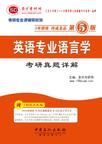英语专业语言学考研真题详解
出版时间:2012-6 出版社:中国石化出版社有限公司 作者:圣才考研网 主编 页数:290 字数:444000
Tag标签:无
前言
目前我国英语专业硕士研究生入学考试没有采取全国统考的方式,没有统一的考试大纲,而是采取各招生院校自行命题、自行组织考试的办法,但是各校的考试要求、命题特点大同小异,一些学校的试题类型、内容难易程度都非常相似,因此,研究一些学校的考研试题非常有价值。我们参照一些名校英语专业硕士研究生入学考试大纲和要求,认真研究了50多所高校300多份英语专业考研科目“英语语言学”真题,精心挑选部分试题和相关资料,并进行了详细的解答,以减轻考生寻找试题及整理答案的痛苦,让读者用最少的时间获得最多的重点题、难点题(包括参考答案),这是本书的目的所在。本书根据众多院校“英语语言学”试题的结构和难易程度,从全国18所院校近年60多份试题中挑选出语言学方向的试题,并提供了详细的参考答案。可以说,通过本书,读者可以了解英语专业硕士研究生入学考试的最高水平和各个院校英语专业考研科目“英语语言学”的出题思路。对于报考语言学方向的考生来说,本书是一本不可多得的辅导资料。圣才考研网提供北大、北外、人大等全国名校英语专业“英语语言学”历年真题解析班(网授),采用高清视频,高分研究生精选讲解2~4套近年考研真题(解析每道真题,详解难点重点)。购买本书享受大礼包增值服务,登录网站,刮开所购图书封面防伪标的密码,即可享受大礼包增值服务:①价值100元的网授班。可冲抵价值100元的网授班学费。②价值20元的真题模考。可免费参加或者下载价值20元的历年真题模拟试题(在线考试)。③价值20元的圣才学习卡。您的账户可以获得20元充值,可在圣才学习网旗下所有网站进行消费。圣才考研网是圣才学习网旗下的考研考博专业网站,提供全国所有院校各个专业的考研考博辅导班(保过班、面授班、网授班等)、经典教材名师讲堂、考研题库(在线考试)、全套资料(历年真题及答案、笔记讲义等)、考研教辅图书等。购书享受大礼包增值服务【100元网授班+20元真题模考+20元圣才学习卡】。
内容概要
《圣才教育·2013考研专业课辅导系列:英语专业语言学考研真题详解(第5版)》是解答名校英语专业考研科目“英语语言学”历年真题的复习资料。它根据众多院校“英语语言学”试题的结构和难易程度,从全国18所院校近几年60多份试题中挑选出语言学方向的试题,并提供了详细的参考答案。
作者简介
圣才考研网,提供全国所有高校各个专业的考研考博辅导班(保过班、网授班、题库等)、国内外经典教材名师讲堂(详细介绍参见本书书前彩页)。
书籍目录
第1章 全国院校英语专业语言学考研真题分析
1.1 语言学考研真题分析
1.2 重点院校语言学考研真题比较
第2章 名校英语专业语言学考研真题详解
1.北京外国语大学语言学考研真题及参考答案(2007-2011)
2.中国人民大学语言学考研真题及参考答案(2002-2007)
3.北京师范大学语言学考研真题及参考答案(2003-2004)
4.对外经济贸易大学语言学考研真题及参考答案(2005-2006)
5.北京第二外国语学院语言学考研真题及参考答案(2005-2010)
6.北京交通大学语言学考研真题及参考答案(2005-2007)
7.北京航空航天大学语言学考研真题及参考答案(2008-2010)
8.上海交通大学语言学考研真题及参考答案(2005-2007)
9.武汉大学语言学考研真题及参考答案(2007-2011)
10. 南京大学语言学考研真题及参考答案(2006-2009)
11. 中山大学语言学考研真题及参考答案(2005-2009,2011)
12.厦门大学语言学考研真题及参考答案(2006-2010)
13.浙江大学语言学考研真题及参考答案(2007,2009)
14.四川大学英语语言学考研真题及参考答案(2006-2010)
15.南开大学语言学考研真题及参考答案(2009-2011)
16.西安外国语学院语言学考研真题及参考答案(2006)
17.西安交通大学语言学考研真题及参考答案(2008)
18. 大连外国语学院语言学考研真题及参考答案(2008)
章节摘录
版权页: 插图: 2. Culture is a semiotic meaning system in which symbols function to communicate meaning from one mind to another. It is related to language in such a way that language is a part of culture and a part of human behavior, and also the primary medium for transmitting much of culture. Therefore, without language, culture would not be possible. Consequently, when studying a culture, we often rely on the language. Therefore, we may use our own language to describe the target culture,which may be the one interpretation of the statement "In studying other cultures, we do so from the perspective of our own culture. " What's more, when studying other cultures, we will definitely come across the differences between the target culture and our own culture. We will subconsciously compare the two different cultures. Seeing from the perspective of our own culture, we find how the target culture is different from our own culture, and this makes the target culture more distinctive from our own. 3. (1) The English present perfect tense is to express the idea that although an action or state happened (or started to happen) in the past, it has some connection with the present. It may be that the (present) result of the action is more important than the action itself. Alternatively, we may be infemng that the action is important, but the time when it occurred is not. ( 2) I may probably choose the top-down approach to lead the students to the recognition of this tense. First, I will list out a group of sentences that are all in the present perfect tense, and make the students generalize the general feature in the form of those sentences, and figure out the basic construction of the present perfect tense, that is "have/has + done". Second, to make the students clear about the conditions in which the present perfect tense canuse, I would tum to pictures to explain the sentences listed out in the lst step; therefore, thestudents can find out the use of this tense in a more visual way. Third, considering the possibility that the students may mix up the present perfect tense with the past tense, I would help students figure out their differences. In this step, pairs of sentences with present perfect tense and past simple tense respectively would be listed out, and accompanying them would be the time axis, which could distinguish the different referring of the two different tenses. The students would found out the differences themselves with the help of the time axis. Fourth, I would create a situation for the students to practice: two friends who haven' t seeneach other for a long time and just met each other. I would encourage the students to make up a dialogue based on such a situation, trying to use the present perfect tense in the places where they think it is appropriate to use it. After students show their dialogue to the class, the class would be asked to decide whether the use of that tense is appropriate according to what they expressed. 4. The misuse shows a separation of the abstract grammatical rules from the everyday use of language. The core of the teaching method above could be said as the habit formation through repetition. This method seems to concem only the formation and performance of habits but not problemsolving. As a result, the students may only know the form, but not know when and where this form is used, which is essential to the actual use of language. This type of teaching reveals the defect of the traditional grammar teaching, that is, it concentrates only on the grammatical forms and the meaning of individual words, whereas the meaning of the whole sentence is thought to be self-evident. Therefore, in conscious training, students may be able to use a grammatical structure correctly, while in the spontaneous and subconscious speech, they may still fail to take the structure into consideration. In other words, they may not know how to use that specific form or expression in adaily communication. The fact that this teaching method is not perfect does not mean that there is no need to teach the grammar. Therefore, it would be inappropriate to label such a lesson as a waste of time. It is true that the students should be taught how to produce appropriate utterances given a communicative situation, yet, they have to know the correct form first, which is greatly related to grammar. It is generally agreed grammar has its due value in language leaming. What's more, there can be some improvements to this lesson. It would be appreciated to add the communicative-oriented tasks in it, which will make the students understand more clearly the situations where the pattem is supposed to be used, and also help the students apply them to the spontaneous communication.
编辑推荐
《圣才•2013考研专业课《英语专业语言学考研真题详解》(第5版)》编辑推荐:购书享受大礼包增值服务“100元网授班+20元真题模考+20元圣才学习卡”。《圣才•2013考研专业课《英语专业语言学考研真题详解》(第5版)》特别适用于参加英语专业硕士研究生入学考试的考生,对于英语专业本科生、自考生以及英语语言学的教学与测试,也具有较好的参考价值。
图书封面
图书标签Tags
无
评论、评分、阅读与下载
用户评论 (总计17条)
- 语言学考研,必备!!!
- 这本书很管用 里面有详细的答案解析 很多人觉得只买卷子看看考什么题就行了 那是不对的 因为很多时候你以为的答案和每个学校要求的答案范围是不一样的 同样的一道简答题 有的学校只需要写出基本意思即可 有的学校就要求必须加上举例说明等等 所以 有答案详解的书很实用(这都是本人考研时的经验和教训之谈啊 无偿献给大家了^ ^)
- 很好很满意,考研必备
- 考研用的 很好 会对我有很大的帮助
- 要考的学校不提供真题,只能参考其他学校的。这个有答案,很好。
- 书不错,很经典,历年 真题,讲解很详细,到货也很快
- 圣才的书的纸质比其他书的纸质差送的券基本没作用都是要花大价钱去报班的
- 很不错,以后要是复习还得买
- 学姐推荐的书,还不错
- 此书,不错,很受益。
- 书还不错,就是纸有点薄
- 还好啦 不过没怎么用上这本书
- 是考研用书,学姐们推荐的
- 都是各大名校的往年真题,拿来练练
- 很好的参考书,答案比较全面
- 这本书还不错 我挺喜欢的
- 各高校题目多半只更新到2011年的 答案仅供参考
